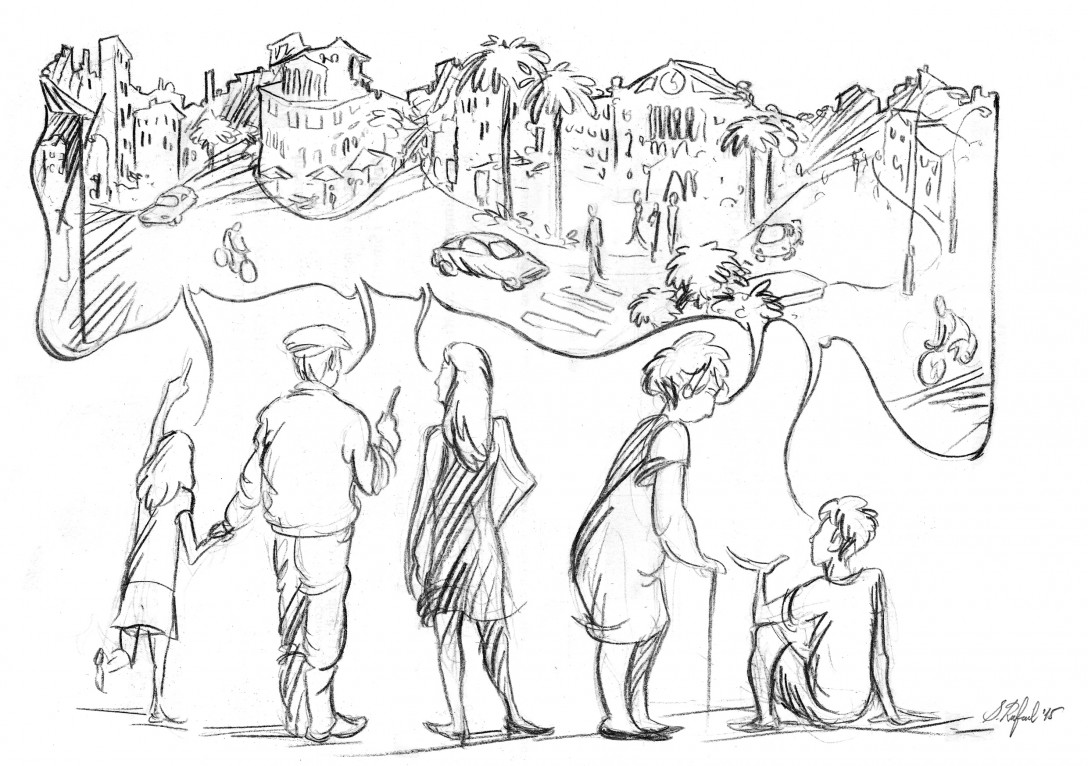This project was initiated in Butetown neighbourhood in Cardiff, but it has during its implementation been expanded to other neighbourhoods in the city.

Loudoun Square, Butetown, February 2016
Butetown was the docklands’ working-class neighbourhood during Cardiff’s heyday as ‘the coal metropolis of the world’ from mid-18th century to mid-20th century. Its name derives from the philanthropic contribution of John Crichton Stuart, the 2nd Marquess of Bute.
Many of those who came from different parts of the world to work in Cardiff’s docklands area settled in Butetown and in its adjacent areas and mingled with the resident population, many of them marrying local Welsh women. The Irish were the first to arrive, many seeking refuge from the Great Irish Famine (1845-49), who settled mainly in Newtown, the so–called ‘Little Ireland’. Then came the English and the Scots. But, as Glenn Jordan highlights, ‘[t]hey were soon joined by immigrants from – it seemed – all over the world’ (2005, pp. 59–60).
Butetown soon became characterised as an area where different ethnic origins, cultural backgrounds and religious beliefs could be found. It is said that by 1950 there were about 6,000 people who accounted for 57 different nationalities living in this area (Lloyd, 1950). This districtt was also most sensationally known as ‘Tiger Bay’. The name was frequently used in the mainstream British media and usually in rather pejorative ways.
However, as the demand for coal progressively dwindled throughout the 20th century, Cardiff endured an acute process of deindustrialisation in tandem with high levels of unemployment, which eventually led to the overall revitalisation of the whole waterfront area, both in urban and economic terms, and to the splintering of this community, whose members were rehoused in other parts of the city or in the city’s suburbs.
Butetown is still nowadays one of the most ethnically diverse districts in Wales. According to the 2011 there were 10,125 people living in the neighbourhood, out of which 34.3% were of Black and minority ethnic (BME) groups.
In 2010 Butetown underwent a £7.6 million Regeneration Scheme which consisted, among others, in the construction of a new community centre, a new youth pavilion and the Butetown Employment and Training Centre.
___________________________________________
Este projeto foi iniciado em Butetown, mas a sua implementação abarcou depois outros bairros da cidade de Cardiff.
Butetown era o bairro da classe trabalhadora das docas de Cardiff durante o seu período áureo como metrópole mundial de carvão desde meados do séc. XVIII até meados do séc. XX. O seu nome advém do apoio à sua construção por parte do filantropo John Crichton Stuart, o 2.º Marquês de Bute.
Muitos dos que vieram de diferentes partes do mundo para trabalhar na área das docas de Cardiff fixaram residência em Butetown e nas suas áreas adjacentes e misturaram-se com a população residente, muitos deles casando com mulheres galesas. Os Irlandeses foram os primeiros a chegar no início do séc. XIX, muitos procurando refúgio da Grande fome na Irlanda (1845-49) e fixaram-se principalmente Newtown, que passou a ser apelidada de ‘Pequena Irlanda’. De seguida vieram os Ingleses e os Escoceses. Mas tal como Glenn Jordan assinalou, a estes juntaram-se imigrantes de várias partes do mundo (2005, pp. 59–60).
Butetown ficou rapidamente conhecida como uma área onde diferentes etnias, culturas e religiões coexistiam. Em 1950 este bairro acolhia cerca de 6,000 pessoas de 57 nacionalidades distintas (Lloyd, 1950), tendo ficado conhecido, de forma mais sensacionalista, como ‘Tiger Bay’. O nome era frequentemente utilizado nos principais média britânicos de forma pejorativa.
No entanto, à medida que a procura de carvão foi diminuindo durante o séc. XX, Cardiff conheceu um profundo processo de desindustrialização que conduziu a um grande nível de desemprego que conduziria à revitalização da frente ribeirinha da cidade e ao desmembramento da comunidade de Butetown, tendo sido os seus membros realojados noutras partes da cidade e nos subúrbios.
Butetown é ainda hoje um dos bairros com maior diversidade étnica do País de Gales. De acordo com o Censos de 2011 viviam na altura 10,125 pessoas no bairro, 34.3% das quais pertenciam a minorias étnicas.
Em 2010 Butetown sofreu um processo de regeneração no valor de £7.6 milhões que consistiu, entre outros, na construção de um centro comunitário, um novo pavilhão para os jovens e de um centro de emprego e formação.
References/Referências
2011 Census Key Statistics – Butetown. Ask Cardiff: Facts & Stats [Online]. Available at: http://formerly.cardiff.gov.uk/content.asp?nav=2872,3257,6571,6572&parent_directory_id=2865&id=13973
Jordan, G. (2005) ‘We Never Really Noticed You Were Coloured’: Postcolonialist Reflections on Immigrants and Minorities in Wales. In Aaron, Jane and Chris Williams, Postcolonial Wales, Cardiff: University of Wales Press.
Lloyd, B. (1950) Down the Bay. Picture Post, 22nd April 1950.

